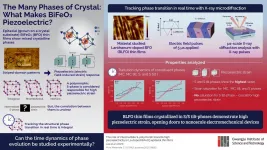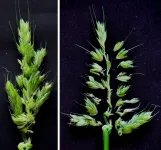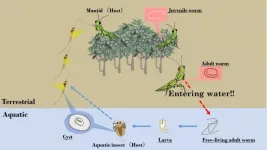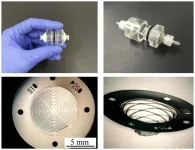(Press-News.org) Tel Aviv University's groundbreaking technology may revolutionize the treatment of cancer and a wide range of diseases and medical conditions. In the framework of this study, the researchers were able to create a new method of transporting RNA-based drugs to a subpopulation of immune cells involved in the inflammation process, and target the disease-inflamed cell without causing damage to other cells.
The study was led by Prof. Dan Peer, a global pioneer in the development of RNA-based therapeutic delivery. He is Tel Aviv University's Vice President for Research and Development, head of the Center for Translational Medicine and a member of both the Shmunis School of Biomedicine and Cancer Research, George S. Wise Faculty of Life Sciences, and the Center for Nanoscience and Nanotechnology. The study was published in the prestigious scientific journal Nature Nanotechnology.
Prof. Peer: "Our development actually changes the world of therapeutic antibodies. Today we flood the body with antibodies that, although selective, damage all the cells that express a specific receptor, regardless of their current form. We have now taken out of the equation healthy cells that can help us, that is, uninflamed cells, and via a simple injection into the bloodstream can silence, express or edit a particular gene exclusively in the cells that are inflamed at that given moment."
As part of the study, Prof. Peer and his team were able to demonstrate this groundbreaking development in animal models of inflammatory bowel diseases such as Crohn's disease and colitis, and improve all inflammatory symptoms, without performing any manipulation on about 85% of the immune system cells. Behind the innovative development stands a simple concept, targeting to a specific receptor conformation.
"On every cell envelope in the body, that is, on the cell membrane, there are receptors that select which substances enter the cell," explains Prof. Peer. "If we want to inject a drug, we have to adapt it to the specific receptors on the target cells, otherwise it will circulate in the bloodstream and do nothing. But some of these receptors are dynamic - they change shape on the membrane according to external or internal signals. We are the first in the world to succeed in creating a drug delivery system that knows how to bind to receptors only in a certain situation, and to skip over the other identical cells, that is, to deliver the drug exclusively to cells that are currently relevant to the disease."
Previously, Prof. Peer and his team developed delivery systems based on fatty nanoparticles - the most advanced system of its kind; this system has already received clinical approval for the delivery of RNA-based drugs to cells. Now, they are trying to make the delivery system even more selective.
According to Prof. Peer, the new breakthrough has possible implications for a wide range of diseases and medical conditions. "Our development has implications for many types of blood cancers and various types of solid cancers, different inflammatory diseases, and viral diseases such as the coronavirus. We now know how to wrap RNA in fat-based particles so that it binds to specific receptors on target cells," he says. "But the target cells are constantly changing. They switch from 'binding' to 'non-binding' mode in accordance with the circumstances. If we get a cut, for example, not all of our immune system cells go into a 'binding' state, because we do not need them all in order to treat a small incision. That is why we have developed a unified protein that knows how to bind only to the active state of the receptors of the immune system cells. We tested the protein we developed in animal models of inflammatory bowel disease, both acute and chronic."
Prof. Peer adds, "We were able to organize the delivery system in such a way that we target to only 14.9% of the cells that were involved in the inflammatory condition of the disease, without adversely affecting the other, non-involved, cells, which are actually completely healthy cells. Through specific binding to the cell sub-population, while delivering the RNA payload we were able to improve all indices of inflammation, from the animal's weight to pro-inflammatory cytokines. We compared our results with those of antibodies that are currently on the market for Crohn's and colitis patients, and found that our results were the same or better, without causing most of the side effects that accompany the introduction of antibodies into the entire cell population. In other words, we were able to deliver the drug 'door-to-door,' directly to the diseased cells."
The study was led by Prof. Peer, together with Dr. Niels Dammes, a postdoctoral fellow from the Netherlands, with the collaboration of Dr. Srinivas Ramishetti, Dr. Meir Goldsmith and Dr. Nuphar Veiga, from Prof. Dan Peer's lab. Professors Jason Darling and Alan Packard of Harvard University in the United States also participated. The study was funded by the European Union, in the framework of the European Research Council (ERC).
INFORMATION:
Link to the article:
https://www.nature.com/articles/s41565-021-00928-x
Research video:
https://youtu.be/bZvlC7i9PQk
What if electricity could be squeezed out of something? It turns out some materials have this property. Piezoelectricity is the electric charge that accumulates in certain solids when mechanical stress is applied on them. Piezoelectric materials, like bismuth ferrite thin films, when grown on a single lanthanum aluminate substrate give rise to highly strained epitaxial thin films that exhibit excellent electromechanical and ferroelectric properties. In bismuth ferrite thin films "doped" or polluted with lanthanum (BLFOs), piezoelectricity is attributed to the presence of "mixed-phase structures" with stripe patterns.
The formation of stripe patterns and controlling the mixed-phase structures of BLFO have been the ...
A FLEET theoretical study out this week has found a 'smoking gun' in the long search for the topological magnetic monopole referred to as the END ...
HARWELL, UK (29 June 2021) Researchers working on the Faraday Institution project on the recycling of lithium-ion batteries (ReLiB) at the Universities of Leicester and Birmingham have solved a critical challenge in the recovery of materials used in electric vehicle batteries at the end of their life, enabling their re-use in the manufacture of new batteries. The new method, which uses ultrasonic waves to separate out valuable material from the electrodes, is 100 times quicker, greener and leads to a higher purity of recovered materials relative to current separation methods.
The research has been published in Green Chemistry and the team have applied for a patent for the technique.
To ...
Patients with mild Covid-19 infections experience a significantly increased longer lasting reduced sense of taste and smell. This is also the case for long-term shortness of breath, although relatively few people are affected. And women and the elderly are particularly affected. This is shown by new research findings from Aarhus University Aarhus University Hospital and Regional Hospital West Jutland
The last 14 months have taught us that there are different symptoms and outcomes of Covid-19. However, the vast majority of people who fall ill with Covid-19 experience mild symptoms and get over ...
Attention Deficit Hyperactivity Disorder (ADHD) affects about 7% of children, with a two out of three chance of persisting into adulthood. This neurodevelopmental disorder is characterised by concentration difficulties, increased distractibility, impulsivity and hyperactivity. Today, ADHD is treated with pharmaceutical drugs that may have unwanted side effects. This is why scientists from the University of Geneva (UNIGE) and the University Hospitals of Geneva (HUG), Switzerland, explored a new technique called 'neurofeedback', which enables ADHD patients to train their attention, based on instant feedback from the level of their brain activity. The team of neuroscientists found that not only did the training have a positive effect on patients' concentration abilities, but also that the ...
An international team of researchers has identified a novel mechanism in barley plants, which could help crop growers achieve high yields as temperatures rise.
With grain production highly sensitive to changing environmental conditions, rising temperatures are known to reduce the number of seeds that can be produced on each plant. One solution is to increase the number of flowers or branches on each 'spike', which is the reproductive structure from which grain is harvested.
In a study published in Nature Plants, research led by Professor Dabing Zhang from the University of Adelaide's Waite Research Institute and Shanghai Jiao Tong University's Joint Lab for Plant Science and Breeding, explored the possibility of increasing seed production through ...
Tsukuba, Japan - As far back as the 1930s, inventors have commercialized fuel cells as a versatile source of power. Now, researchers from Japan have highlighted the impressive chemistry of an essential component of an upcoming fuel cell technology.
In a study recently published in The Journal of Physical Chemistry Letters, researchers from the University of Tsukuba have revealed successive proton transport--energy transfer--in an advanced carbon-based crystal for future fuel cells, and the chemistry that underpins this phenomenon.
Such crystals are exciting as solid electrolytes--energy transfer media--in upcoming fuel cell technologies. Solid electrolytes have advantages, such as high power efficiency and long-term ...
Researchers have revealed that praying mantis (mantids) infected with parasitic hairworms are attracted to horizontally polarized light that is strongly reflected off the surface of water, which causes them to enter the water. In a world-first, these research results demonstrate that parasites can manipulate the host's specific light perception system to their advantage, causing the host to behave in an abnormal manner.
This discovery was made by an international research group consisting of Graduate student OBAYASHI Nasono, Associate Professor SAKURA Midori and Associate Professor SATO Takuya of Kobe University's Graduate School of Science, Associate Professor IWATANI Yasushi (Faculty of Science and Technology, Hirosaki University), ...
A team of scientists from Nanyang Technological University, Singapore (NTU Singapore) has developed a test kit for malaria that delivers results in 30 minutes. The kit could facilitate the diagnosis of malaria in the field, as the equipment needed is anticipated to be lightweight, easy-to-use, and able to detect the disease in its early stages.
According to the World Health Organisation (WHO), an estimated 229 million people suffered from malaria in 2019. The disease, transmitted by mosquitoes, caused the deaths of 409,000 people across 87 mainly developing countries.
Efforts to treat and control malaria in ...
A microfilter device that can easily separate and capture trace amounts of cancer cells in blood has been developed by a Kumamoto University research group. The palm-sized device is expected to contribute to the development of new cancer diagnostic technologies based on cancer cells in the blood, such as early detection by blood test, postoperative management, and recurrence monitoring.
The blood of people with cancer contains trace amounts of cancer cells (CTCs) that have detached from the primary cancer site. However, the amount of these cells is only a few per milliliter, whereas red or white blood cells number in the billions, making ...






